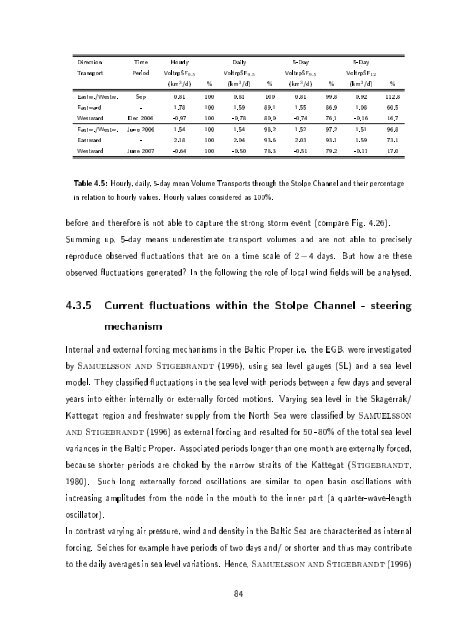Baltic Sea
Baltic Sea
Baltic Sea
Create successful ePaper yourself
Turn your PDF publications into a flip-book with our unique Google optimized e-Paper software.
Direction Time Hourly Daily 5-Day 5-Day<br />
Transport Period VoltrpSF 9.5 VoltrpSF 9.5 VoltrpSF 9.5 VoltrpSF 12<br />
(km 3 /d) % (km 3 /d) % (km 3 /d) % (km 3 /d) %<br />
Eastw./Westw. Sep 0.81 100 0.81 100 0.81 99.8 0.92 112.8<br />
Eastward - 1.78 100 1.59 89.1 1.55 86.9 1.08 60.5<br />
Westward Dec 2006 -0.97 100 -0.78 80.0 -0.74 76.1 -0.16 16.7<br />
Eastw./Westw. June 2006 1.54 100 1.54 98.2 1.52 97.2 1.51 96.8<br />
Eastward - 2.18 100 2.04 93.6 2.03 93.1 1.59 73.1<br />
Westward June 2007 -0.64 100 -0.50 78.3 -0.51 79.2 -0.11 17.0<br />
Table 4.5: Hourly, daily, 5-day mean Volume Transports through the Stolpe Channel and their percentage<br />
in relation to hourly values. Hourly values considered as 100%.<br />
before and therefore is not able to capture the strong storm event (compare Fig. 4.26).<br />
Summing up, 5-day means underestimate transport volumes and are not able to precisely<br />
reproduce observed uctuations that are on a time scale of 2 − 4 days. But how are these<br />
observed uctuations generated? In the following the role of local wind elds will be analysed.<br />
4.3.5 Current uctuations within the Stolpe Channel - steering<br />
mechanism<br />
Internal and external forcing mechanisms in the <strong>Baltic</strong> Proper i.e. the EGB, were investigated<br />
by Samuelsson and Stigebrandt (1996), using sea level gauges (SL) and a sea level<br />
model. They classied uctuations in the sea level with periods between a few days and several<br />
years into either internally or externally forced motions. Varying sea level in the Skagerrak/<br />
Kattegat region and freshwater supply from the North <strong>Sea</strong> were classied by Samuelsson<br />
and Stigebrandt (1996) as external forcing and resulted for 50 - 80% of the total sea level<br />
variances in the <strong>Baltic</strong> Proper. Associated periods longer than one month are externally forced,<br />
because shorter periods are choked by the narrow straits of the Kattegat (Stigebrandt,<br />
1980). Such long externally forced oscillations are similar to open basin oscillations with<br />
increasing amplitudes from the node in the mouth to the inner part (a quarter-wave-length<br />
oscillator).<br />
In contrast varying air pressure, wind and density in the <strong>Baltic</strong> <strong>Sea</strong> are characterised as internal<br />
forcing. Seiches for example have periods of two days and/ or shorter and thus may contribute<br />
to the daily averages in sea level variations. Hence, Samuelsson and Stigebrandt (1996)<br />
84



